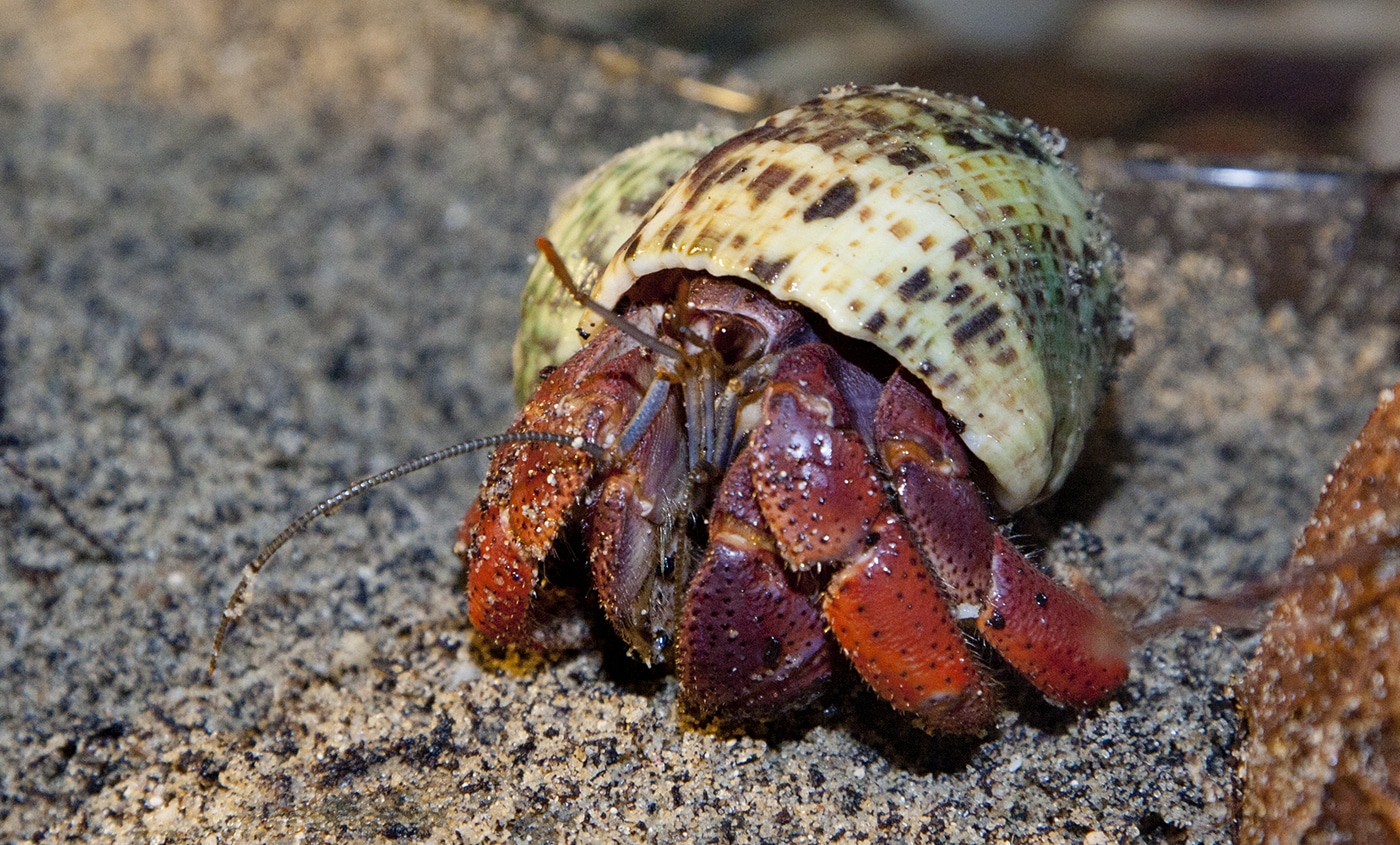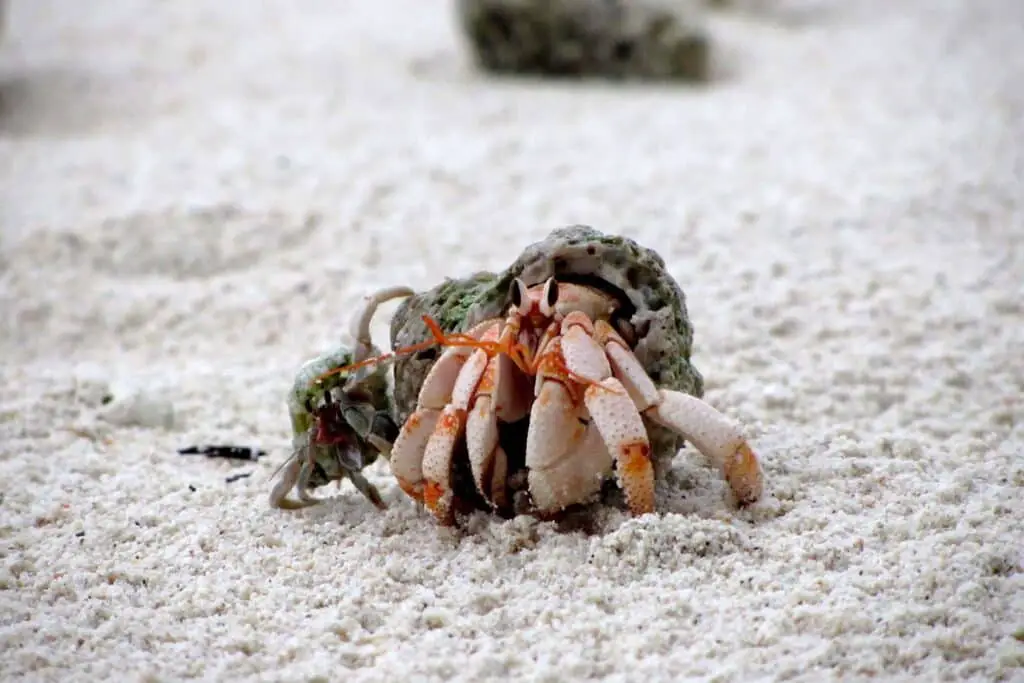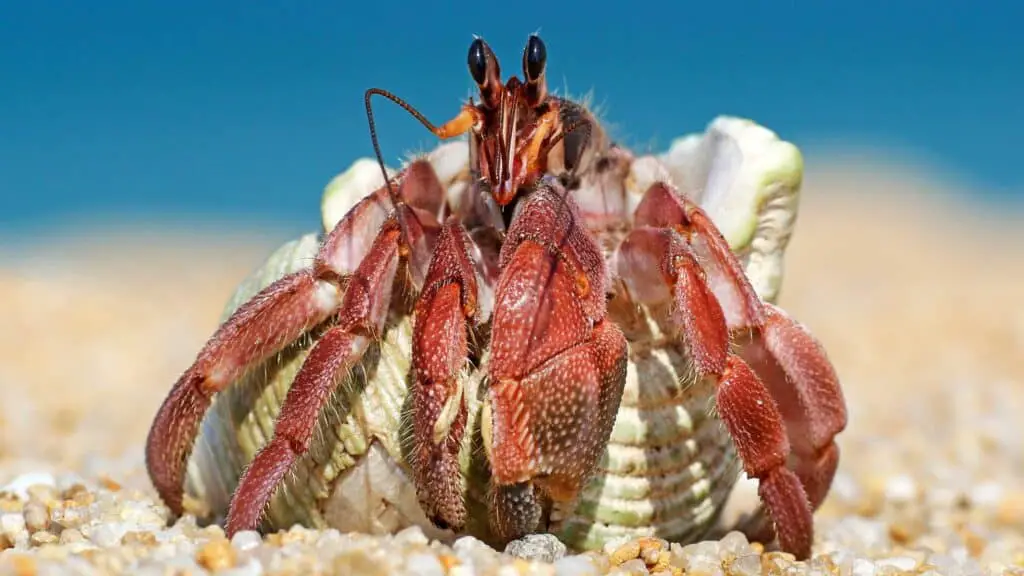What Do Hermit Crabs Need

Introduction
What Do Hermit Crabs Need: Hermit crabs, those intriguing little creatures with their intricate shells and comical antics, have captured the fascination of many as unique and endearing pets. While they may seem low-maintenance at first glance, providing hermit crabs with the care they need to thrive is essential. Understanding what these crustaceans require in terms of shelter, food, humidity, and overall habitat is crucial for responsible pet ownership.
One of the most distinctive features of hermit crabs is their use of empty shells as protective homes. As they grow, they must find new, larger shells to accommodate their increasing size. Providing a variety of shell options in their enclosure is essential to ensure their well-being. A proper diet is vital for hermit crabs’ health and longevity.
Maintaining the right humidity level within their habitat is another critical factor in caring for hermit crabs. These creatures have gills that need moisture to breathe, so it’s essential to provide a moist environment to prevent desiccation. Finally, creating a safe, comfortable enclosure with suitable substrate and temperature control is essential for their overall welfare.
In this comprehensive guide, we will delve deeper into what hermit crabs need to thrive as pets. Whether you’re a seasoned hermit crab owner or considering bringing these captivating creatures into your life, understanding their requirements is the first step towards ensuring their well-being and happiness.

What things do you need for a hermit crab?
Make sure food and water bowls are always accessible. Hermit crabs need an environment with high humidity to keep moist, which enables them to breathe properly. Purchase a humidity gauge to ensure your tank maintains a humidity level of 70–80%.
To provide proper care for hermit crabs, you’ll need a few essential items to create a suitable habitat:
- Enclosure: Choose a tank or terrarium that offers enough space for your hermit crabs to move around comfortably. A 10-gallon tank is a good starting point for a few hermit crabs.
- Substrate: Use a mix of sand and coconut coir or a special hermit crab substrate for the tank’s bottom. This provides the right texture for burrowing and helps maintain proper humidity.
- Shells: Offer a variety of empty shells in different sizes and shapes to allow your hermit crabs to change homes as they grow.
- Water and Food Dishes: Provide shallow, non-toxic dishes for fresh water and a separate dish for food. Both should be easily accessible to your crabs.
- Humidity and Temperature Control: Maintain a humidity level of 70-80% within the enclosure using a spray bottle and a hygrometer to monitor it. Keep the temperature in the range of 75-85°F (24-29°C) using a heat lamp or heat pad.
- Hideouts and Decor: Add some hiding spots like coconut huts or shells, as well as safe, non-toxic decorations to create a stimulating environment.
By ensuring you have these items and understanding their importance, you can provide a comfortable and enriching environment for your hermit crabs, promoting their well-being and longevity as fascinating pets.
Are hermit crabs easy to keep alive?
Hermit Crabs are very simple to care for, however there are many dos and don’ts to keeping them. Hermit Crabs make great pets because they do not carry any known disease and are hypoallergenic, which make Hermit Crabs a perfect pet for those with allergies.
Hermit crabs can be relatively easy to keep alive with proper care, but they do require specific attention and maintenance to thrive. Whether they are considered easy to care for depends on an individual’s dedication and willingness to meet their needs.
On the positive side, hermit crabs are not demanding in terms of space and are generally hardy. They are also fascinating to observe, making them appealing pets for many. However, they do have some specific requirements that need careful consideration:
- Humidity and Temperature: Hermit crabs are sensitive to changes in humidity and temperature. Maintaining the right levels is crucial for their well-being.
- Shells and Growth: Hermit crabs need a variety of shells as they grow, and finding the right fit is vital. Providing the right options can be challenging.
- Diet: Their diet includes fresh foods, and maintaining variety can be a bit more involved compared to some other pets.
- Longevity: Hermit crabs can live for a decade or longer with proper care, which is a significant commitment.
While hermit crabs are not excessively demanding, they are not entirely low-maintenance either. As with any pet, responsible ownership involves research, effort, and attention to their specific needs. For those willing to invest the time and effort, keeping hermit crabs alive and healthy can be a rewarding experience filled with the joy of observing these unique creatures in action.
Do hermit crabs need water or sand?
Shell water is important to a hermit crab. They use the shell water to hydrate their gills and will regulate its salinity (osmoregulation) based on their needs by switching between the fresh and saltwater dish. It is important that they have access to both fresh and salt water at all times.
Hermit crabs require both water and sand in their habitat to meet their unique needs. These elements play crucial roles in their overall well-being:
Water: Hermit crabs need access to both fresh water and salt water. Fresh water is for drinking and maintaining humidity levels in their environment. The salt water, often referred to as “saltwater pools,” is essential for them to bathe and replenish the salts their bodies require. Providing a dish of dechlorinated fresh water and another with marine salt mix diluted to the proper salinity ensures they have access to these vital resources.
Sand: A substrate of sand mixed with coconut coir or another appropriate material is essential for hermit crabs. They use this substrate for burrowing, which is a natural behavior that helps them molt and hide. The substrate also helps maintain the necessary humidity levels within the enclosure, crucial for their respiration and overall health.
Hermit crabs need both water and sand in their habitat. Fresh water and saltwater pools provide hydration and a place to soak, while the sandy substrate enables them to engage in natural behaviors. Balancing these elements is key to creating a suitable environment for these captivating crustaceans in captivity.
What do hermit crabs like doing?
Hermit crabs love to climb, so include driftwood pieces or mangrove roots within the aquarium to provide some entertainment. Hermit crabs require humidity of around 50-70%. They need this to keep their gills moist and to breathe properly. If the air is too dry, your hermit crab might become inactive and suffocate.
Hermit crabs, fascinating creatures of the sea, have a unique set of preferences and behaviors that reflect their adaptation to life in the ocean. One of their favorite activities is searching for suitable shells to call home. Hermit crabs are notorious for their habit of scavenging and switching shells as they grow. They are always on the lookout for larger and more spacious shells to accommodate their increasing size.
Another activity hermit crabs enjoy is exploring their surroundings. They are known for their curious nature, constantly on the move, and actively inspecting the nooks and crannies of their underwater environment. Whether it’s inspecting coral reefs, investigating the ocean floor, or simply strolling along the sandy seabed, hermit crabs are natural explorers.
They often gather in groups, forming a sense of community and safety in numbers. These gatherings serve not only as a way to socialize but also as an opportunity to exchange shells when they outgrow their current homes.
Hermit crabs are creatures of both curiosity and necessity. Their activities revolve around finding suitable shelter, exploring their surroundings, and engaging in social interactions within the intricate world of the ocean.
Can hermit crabs live alone?
Hermit crabs are social creatures that like to live in large groups. Because of this, they can get lonely if left alone for too long. One option to prevent loneliness is to get multiple crabs. If you do add one or more hermit crabs to an existing tank, keep an eye out for fighting.
Hermit crabs, despite their name, are not solitary creatures by nature. They are social animals that often prefer to live in groups or colonies. While it’s possible for a hermit crab to live alone, it’s generally not ideal for their well-being.
Hermit crabs display social behaviors and interactions within their groups. They communicate through body language and tactile signals, such as antennae touching, which helps in maintaining social cohesion and safety. Living in a group provides several benefits for hermit crabs. They can share information about suitable food sources, exchange shells when needed, and even offer protection from predators through collective vigilance.
In captivity, when a hermit crab is kept alone, it can experience loneliness and stress. Solitary hermit crabs might exhibit unusual behaviors or become less active. They may also have difficulty finding new shells without the help of other crabs, which is crucial for their growth and survival.
How do I introduce new hermit crabs to an existing group?
Create a separate enclosure, ideally with similar environmental conditions to the original habitat. This helps in minimizing stress for both the newcomers and established members. Gradually acclimate the new crabs by placing them in the same room as the existing group for a few hours each day, allowing them to get accustomed to each other’s presence without direct contact.
Before the introduction, it’s crucial to provide an array of hiding spots and ample space to prevent territorial disputes. Additionally, ensure that there’s an adequate supply of food and water to prevent competition and promote a sense of security. Observe their behavior closely during this period, paying attention to any signs of aggression or distress.
When the time comes for the actual introduction, do it in a neutral territory within the main enclosure. Monitor their interactions closely, intervening if aggressive behavior occurs. It’s normal for some initial posturing or light skirmishes, but if conflicts persist, consider temporarily separating them and retrying the introduction later.
Patience is key in this process, as it may take days or even weeks for the crabs to establish a new hierarchy and coexist peacefully. Regular monitoring and adjustments to the habitat will help ensure a smooth integration, ultimately leading to a thriving, balanced crab community.
What signs indicate that my hermit crab is unhealthy or stressed?
Identifying signs of stress or illness in a hermit crab is crucial for its well-being. One clear indicator is changes in behavior. If a typically active crab becomes lethargic or hides excessively, it may signal a problem. Similarly, if it consistently stays out of its shell or exhibits unusual restlessness, it’s cause for concern.
Physical cues are also telling. A discolored exoskeleton, particularly if it appears dull or disintegrating, is a red flag. Likewise, any abnormal growths, lesions, or signs of injury demand immediate attention. Pay attention to its eyes as well; cloudy or swollen eyes can signify health issues.
Inspect the crab’s shell, as it’s an integral part of their anatomy. If it appears damaged, or if the crab has abandoned it altogether, it suggests distress. Foul odors emanating from the enclosure could indicate a bacterial infection or unsanitary conditions.
A sudden loss of interest in food, or conversely, excessive eating, can signify stress or an underlying health issue. Additionally, irregularities in molting, such as prolonged periods between molts or difficulties shedding, can be problematic. Regular observation and prompt action are essential in maintaining the health of your hermit crab.
Can hermit crabs live in freshwater permanently?
Hermit crabs are primarily marine creatures and require access to saltwater for their survival. They have specialised gills that extract oxygen from water, which is essential for their respiratory process. Attempting to keep hermit crabs in freshwater permanently would be detrimental to their health and well-being.
While they can briefly tolerate freshwater, it’s not a suitable long-term environment. Prolonged exposure to freshwater can lead to stress, respiratory issues, and ultimately, it can be fatal. Without the proper salinity levels, their gills will struggle to extract the necessary oxygen from the water.
In their natural habitat, hermit crabs are found along coastal areas, where they have access to both saltwater and land. In captivity, it’s crucial to replicate this environment by providing them with a shallow saltwater pool or dish, along with a land area, usually consisting of sand or substrate.
Hermit crabs cannot thrive in freshwater permanently. Maintaining the correct salinity levels in their habitat is vital for their health and overall well-being. Always ensure that they have access to the appropriate saltwater environment to mimic their natural habitat.

Conclusion
Providing hermit crabs with what they need to thrive as pets is a rewarding responsibility. These fascinating crustaceans require more care and attention than one might initially assume. Ensuring they have a variety of suitable shells for their continuous growth, offering a well-rounded diet, and maintaining proper humidity levels in their habitat are all crucial aspects of their care.
Additionally, creating a safe and comfortable marine environment with appropriate substrate and temperature control is essential for their overall well-being. Hermit crabs may be small in size, but they have specific needs that must be met to ensure they live long, healthy lives in captivity.
Understanding and meeting these requirements not only promotes their physical health but also enhances their natural behaviors and overall quality of life. As responsible pet owners, it is our duty to provide for the well-being of these unique creatures.
By following the guidelines outlined in this guide, you can create a suitable home for your hermit crabs and enjoy the joy of watching them thrive. Hermit crabs have a lot to offer as pets, with their curious personalities and captivating shell-swapping antics, making the effort to meet their needs well worth it.



